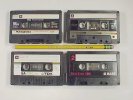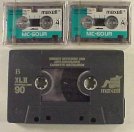Old Recordings Discs Tapes Wires Dictation Belts Other Media
| The Phillips standard cassette, using 1/8" wide tape, was first
brought out in the U.S. during 1966 and Dolby noise reduction added
during 1970. RCA had earlier and unsuccessfully marketed a jumbo version
of the now familiar audio cassette in 1954, using ¼" wide tape to
record in stereo.



The Phillips system used thin tapes in lengths which played for up to 90 minutes, or 45 minutes per side. A thinner tape which could record up to 120 minutes arrived later and is more prone to stretching, slowing, wrinkling and jamming. Microcassettes are much smaller, 1-1/4" x 2". I can change the order of selections, even out levels, take out extraneous noises and put in track markers for the CD. So can you, on your computer with a decent sound card and sound editing system and some time with the instruction manual. My services are helpful when things have gone wrong. Many cassette recorder users were not aware their machines had to be cleaned and the heads demagnetized. Without this basic maintenance, the tapes they made became hissy and lost high frequencies. A similar muffled sound may also mean a Dolby or DBX noise reduction system was used to record but was not switched in during playback. Occasionally a miscalibrated noise reduction setting at the factory was used in making the recording. I can often figure out the problem's source and compensate for it. I also fix broken cassettes and put them into new shells and can adjust playback speeds when weak batteries caused the tape to slow. I'm gradually bringing on line some of the cassettes not compatible with any of the standard formats and which were used in office dictation machines over the years. I've just restored a DeJur Grundig Stenorette V. BASIC COPYING: Cassettes take a bit more than their playing time to put the sound onto the computer hard disc. C-60s fit on one CD. C-90s play for 90 minutes, C-120s for 120 minutes. A CD will hold no more than 80 minutesof audio so two CDs are needed for the latter two lengths. Further material can be added to fill up the second CD. A C-60 cassette costs $ 80 to copy; a C-90 costs $ 110, a C-120 $ 140. Trimming the excess time and loping off starting end ending noises, removing the silence between the end of one side and start of the next, making some of the softer portions loud in proportion to the loudest parts, hum reduction, etc., is an additional $ 25-$50, depending on how much is to be done. The 120s are the most troublesome in terms of extra help usually required. ADDITIONAL SERVICES: To fix a broken cassette tape and installing it into a new shell is $ 50 plus $ 5.00 shipping to the US, provided there is no tape damage to be repaired as well. Editing out extraneous clicks and other sudden noises can take an consideable time since this work cannot usually be automated. Whipping, the noise made by abruptly starting the recorder, can be reduced but not removed. As the program can not differentiate between contntent and noise and the quality and quantity of tape problems vary, I'll usually discuss work at this level with you after I've done the basic transfer and heard the recording. The tape in battery operated cassette recorders slows down as the power becomes exhausted. When played back, it sounds increasingly faster. Fixing this takes four to six times the playing time for speech, more if music, as variations from the original pitch are more noticeable. A 45 minute side of a C-90 of spoken sound costs between $ 300 and $ 450 to even out. As the batteries expire, the audio signal becomes increasingly faint until it is quieter than the tape's inherent background noise. I can recover much of this but often not all. The voice becomes increasingly artificial and generic as more computer power is applied to push the tape noise back. Processing at this level usually takes double the tape's playing time.
This site ©2001 Steven Smolian. rev. 2 |
